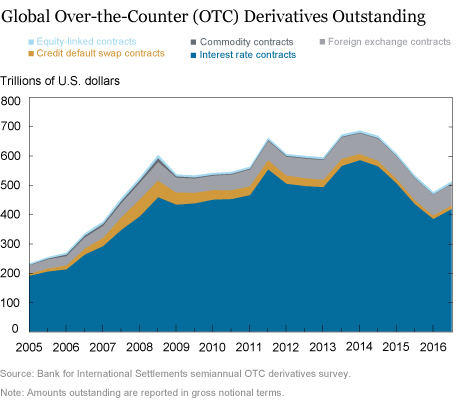The 2007-09 financial crisis highlighted weaknesses in the over‑the‑counter (OTC) derivatives markets and the increased risk of contagion due to the interconnectedness of market participants in these markets. As a response, the global regulatory community introduced a number of reforms to both the market structure and the regulatory environment. The intent of these innovations was to improve the functioning of OTC markets but some market participants have suggested that some of the new regulations may have had unintended consequences. In this post, we discuss some key takeaways from a recent two-day conference on “Over‑the‑Counter Derivatives and Recent Regulatory Changes,” where policymakers, academics, practitioners, and other experts convened to discuss the evolution of OTC derivatives markets after the crisis.
In the run-up to the financial crisis, OTC derivatives markets grew rapidly, with interest rate and credit derivatives growing the fastest, as shown in the chart below. While these derivatives provide an important vehicle for hedging economic risks, recent academic literature has argued that market participants also use these markets to take speculative directional exposures. Regulatory efforts post-crisis have concentrated on improving the functioning of OTC derivatives markets, reducing excessive risk-taking and appropriately managing the risks associated with these products. Though the notional amount outstanding has declined in recent years, at more than $500 trillion outstanding, OTC derivatives remain an important asset class.

The policy-oriented panel in the morning of the first day set the scene for the conference. The discussion centered on three broad reform agendas: central clearing, electronic trading platforms for standardized derivatives, and higher capital and margin requirements for non-cleared derivatives. These agendas serve complementary objectives; the centralization of clearing promotes financial stability, while trading for standardized derivatives, together with public dissemination of trade statistics, provide transparency to previously opaque markets, and higher capital and margin requirements for non-cleared trades provide incentives for market participants to clear eligible trades and to manage appropriately the risks associated with these transactions.
The panelists noted that the financial stability benefits of regulatory changes have to be weighed against the potential costs, for example, of reducing market liquidity or financial intermediation. They also highlighted a potential vulnerability of central counterparties (CCPs) in the event of the failure of a clearing member whose institution also provides vital services to the CCP, such as in the form of liquidity facilities, credit lines, settlement services, custodial arrangements, and default management actions. While CCPs are designed to withstand the failure of their top clearing members (thereby reducing the likelihood of contagion in stress), it is not known to what extent the interdependencies between CCPs and their critical members would reduce the transmission of funding shocks.
In addition, the panelists remarked that, while the new trading, clearing, capital, and margin requirements have not generated the expected levels of derivatives market standardization, these requirements may be driving new market behaviors. For example, higher margin requirements for bilateral contracts may incentivize different types of institutions to become CCP members, while higher capital requirements may lead to fewer traditional intermediaries providing clearing services. In a later panel, market participants echoed these sentiments, and noted that some CCPs are evaluating the possibility of allowing direct access for buy-side firms to mitigate the impact of capital regulation on the market.
Both panels agreed on the need for greater standardization of regulations across jurisdictions and for harmonization between prudential and market-practice regulations. Discussion during the market participants panel also highlighted that regulations have disparate impact on different types of financial institutions. For example, mandatory clearing and higher margin requirements for non-cleared derivatives are having unintended consequences for end users of derivatives. In particular, institutions that use derivatives to hedge unexpected changes to their liabilities engage in bilateral contracts to match their exposures; the higher margin requirements for non-cleared trades thus increase their hedging costs and may reduce their willingness to hedge.
Overall, the discussion at the conference revolved around whether the post-crisis changes in market practices and the regulatory environment are having the intended effects on financial institutions’ behavior. Panelists lauded efforts that aim to reform the undesirable features of these markets, such as counterparty risk in bilateral contracts and market opaqueness, while preserving the crucial role they play in insuring market participants against interest rate, credit, and exchange rate risks. They added that unintended consequences, such as CCP fragmentation, can be further addressed as they are recognized. Possible further innovations to market practice and regulatory landscapes warrant consideration, given that OTC derivatives remain a significant part of the financial landscape.
Disclaimer
The views expressed in this post are those of the authors and do not necessarily reflect the position of the Federal Reserve Bank of New York or the Federal Reserve System. Any errors or omissions are the responsibility of the authors.
 Nina Boyarchenko is an economist in the Federal Reserve Bank of New York’s Research and Statistics Group.
Nina Boyarchenko is an economist in the Federal Reserve Bank of New York’s Research and Statistics Group.
 Or Shachar is an economist in the Bank’s Research and Statistics Group.
Or Shachar is an economist in the Bank’s Research and Statistics Group.
 Jacqueline Yen is a quantitative and policy analysis manager in the Bank’s Markets Group.
Jacqueline Yen is a quantitative and policy analysis manager in the Bank’s Markets Group.
How to cite this blog post:
Nina Boyarchenko, Or Shachar, and Jacqueline Yen, “At the N.Y. Fed: The Evolution of OTC Derivatives Markets,” Federal Reserve Bank of New York Liberty Street Economics (blog), May 12, 2017,
Permalink: http://libertystreeteconomics.newyorkfed.org/2017/05/at-the-ny-fed-the-evolution-of-otc-derivatives-markets.html.











 RSS Feed
RSS Feed Follow Liberty Street Economics
Follow Liberty Street Economics